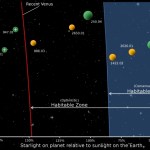Planets, planets everywhere
and on some there will be drops to drink.
An interesting confluence of research occurred over the last few months, leading to:
"A revised estimate of the occurrence rate of terrestrial planets in the habitable zones around Kepler M-dwarfs" by Ravi kumar Kopparapu PSU (arXiv), ApJLetters in press
Bottom line: about half of low mass stars in the Solar neighbourhood are estimated to have earth size planets in their habitable zone!
The implications are that habitable planets may be very common and the closest one within a few light years.
We'll know for sure very…
habitable zone
Given ηEarth=1
Find more terrestrial exoplanets.
Find habitable terrestrial exoplanets.
Find inhabited terrestrial exoplanets.
Go visit.
Consider the following snippets:
Kepler discover 5 planets orbiting inside 0.1 AU
Kepler: A Transiting Circumbinary Planet in a Quadruple Star System
Terrestrial mass planet discovered around α Cen B
Kepler exoplanet survey jeopardized
Kepler has lost one of its reaction wheels.
That was the spare, one more goes, and it will not complete its mission, it will not be able to stay pointed at its target.
Because of stellar jitter, the science goal for Kepler,…
α Centauri B, a mere 4 lightyears away has a terrestrial planet orbiting it.
α Cen B b
The most interesting aspect of the discovery may be the inferences we can make rather than the planet itself.
The discovery by the Geneva Observatory team using the
HARPS spectrograph is a wonderful example of precision high cadence spectroscopy and the ability of observers to find planets wherever they may be. The precision of the measurment is 0.5 m/sec, which is astonishing.
The discovery will be published in Nature (X. Dumusque et al. Nature 17 Oct 2012) thursday, and was due to be announced…
